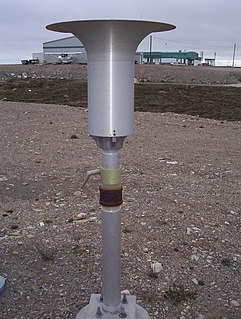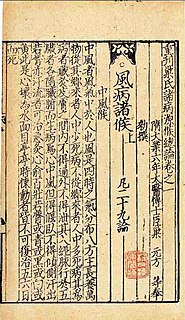
Meteorology is a branch of the atmospheric sciences, with a major focus on weather forecasting. The study of meteorology dates back millennia, though significant progress in meteorology did not begin until the 18th century. The 19th century saw modest progress in the field after weather observation networks were formed across broad regions. Prior attempts at prediction of weather depended on historical data. It was not until after the elucidation of the laws of physics and more particularly, the development of the computer, allowing for the automated solution of a great many equations that model the weather, in the latter half of the 20th century that significant breakthroughs in weather forecasting were achieved. An important branch of weather forecasting is marine weather forecasting as it relates to maritime and coastal safety, in which weather effects also include atmospheric interactions with large bodies of water.

Snow comprises individual ice crystals that grow while suspended in the atmosphere—usually within clouds—and then fall, accumulating on the ground where they undergo further changes. It consists of frozen crystalline water throughout its life cycle, starting when, under suitable conditions, the ice crystals form in the atmosphere, increase to millimeter size, precipitate and accumulate on surfaces, then metamorphose in place, and ultimately melt, slide or sublimate away.
Zhu Shijie, courtesy name Hanqing (漢卿), pseudonym Songting (松庭), was a Chinese mathematician and writer. He was a Chinese mathematician during the Yuan Dynasty. Zhu was born close to today's Beijing. Two of his mathematical works have survived. Introduction to Computational Studies, and Jade Mirror of the Four Unknowns.

A rain gauge is an instrument used by meteorologists and hydrologists to gather and measure the amount of liquid precipitation over an area in a predefined area, over a period of time. It is used for determining the depth of precipitation that occurs over a unit area and thus measuring rainfall amount.

A weather station is a facility, either on land or sea, with instruments and equipment for measuring atmospheric conditions to provide information for weather forecasts and to study the weather and climate. The measurements taken include temperature, atmospheric pressure, humidity, wind speed, wind direction, and precipitation amounts. Wind measurements are taken with as few other obstructions as possible, while temperature and humidity measurements are kept free from direct solar radiation, or insolation. Manual observations are taken at least once daily, while automated measurements are taken at least once an hour. Weather conditions out at sea are taken by ships and buoys, which measure slightly different meteorological quantities such as sea surface temperature (SST), wave height, and wave period. Drifting weather buoys outnumber their moored versions by a significant amount.
The timeline of meteorology contains events of scientific and technological advancements in the area of atmospheric sciences. The most notable advancements in observational meteorology, weather forecasting, climatology, atmospheric chemistry, and atmospheric physics are listed chronologically. Some historical weather events are included that mark time periods where advancements were made, or even that sparked policy change.

A hygrometer is an instrument used to measure the amount of water vapor in air, in soil, or in confined spaces. Humidity measurement instruments usually rely on measurements of some other quantities such as temperature, pressure, mass, a mechanical or electrical change in a substance as moisture is absorbed. By calibration and calculation, these measured quantities can lead to a measurement of humidity. Modern electronic devices use temperature of condensation, or changes in electrical capacitance or resistance to measure humidity differences. A crude hygrometer was invented by Leonardo da Vinci in 1480. Major leaps came forward during the 1600s; Francesco Folli invented a more practical version of the device, while Robert Hooke improved a number of meteorological devices including the hygrometer. A more modern version was created by Swiss polymath Johann Heinrich Lambert in 1755. Later, in the year 1783, Swiss physicist and Geologist Horace Bénédict de Saussure invented the first hygrometer using human hair to measure humidity.

In meteorology, precipitation is any product of the condensation of atmospheric water vapor that falls under gravitational pull from clouds. The main forms of precipitation include drizzling, rain, sleet, snow, ice pellets, graupel and hail. Precipitation occurs when a portion of the atmosphere becomes saturated with water vapor, so that the water condenses and "precipitates" or falls. Thus, fog and mist are not precipitation but colloids, because the water vapor does not condense sufficiently to precipitate. Two processes, possibly acting together, can lead to air becoming saturated: cooling the air or adding water vapor to the air. Precipitation forms as smaller droplets coalesce via collision with other rain drops or ice crystals within a cloud. Short, intense periods of rain in scattered locations are called showers.

Qin Jiushao, courtesy name Daogu (道古), was a Chinese mathematician, meteorologist, inventor, politician, and writer. He is credited for discovering Horner's method as well as inventing Tianchi basins, a type of rain gauge instrument used to gather meteorological data.

Mathematics in China emerged independently by the 11th century BC. The Chinese independently developed a real number system that includes significantly large and negative numbers, more than one numeral system, algebra, geometry, number theory and trigonometry.

A snow gauge is a type of instrument used by meteorologists and hydrologists to gather and measure the amount of solid precipitation over a set period of time.
The history of measurement systems in India begins in early Indus Valley Civilisation with the earliest surviving samples dated to the 5th millennium BCE. Since early times the adoption of standard weights and measures has reflected in the country's architectural, folk, and metallurgical artifacts. A complex system of weights and measures was adopted by the Maurya empire, which also formulated regulations for the usage of this system. Later, the Mughal empire (1526–1857) used standard measures to determine land holdings and collect land tax as a part of Mughal land reforms. The formal metrication in India is dated to 1 October 1958 when the Indian Government adopted the International System of Units (SI).

The Mathematical Treatise in Nine Sections is a mathematical text written by Chinese Southern Song dynasty mathematician Qin Jiushao in the year 1247. The mathematical text has a wide range of topics and is taken from all aspects of the society of that time, including agriculture, astronomy, water conservancy, urban layout, construction engineering, surveying, taxation, armament, military and so on.

The following outline is provided as an overview of and topical guide to the field of Meteorology.

Rain is liquid water in the form of droplets that have condensed from atmospheric water vapor and then become heavy enough to fall under gravity. Rain is a major component of the water cycle and is responsible for depositing most of the fresh water on the Earth. It provides suitable conditions for many types of ecosystems, as well as water for hydroelectric power plants and crop irrigation.
Early writing on mineralogy, especially on gemstones, comes from ancient Babylonia, the ancient Greco-Roman world, ancient and medieval China, and Sanskrit texts from ancient India. Books on the subject included the Naturalis Historia of Pliny the Elder which not only described many different minerals but also explained many of their properties. The German Renaissance specialist Georgius Agricola wrote works such as De re metallica and De Natura Fossilium which began the scientific approach to the subject. Systematic scientific studies of minerals and rocks developed in post-Renaissance Europe. The modern study of mineralogy was founded on the principles of crystallography and microscopic study of rock sections with the invention of the microscope in the 17th century.

Yunjin, Nanjing brocade or Cloud brocade, is a traditional Chinese luxury silk brocade made in Nanjing since the end of the Song dynasty, and based on weft-weaving techniques from both the Song and Tang dynasties. It is shuttle-woven, and often incorporates gold and silver threads with the coloured silks. During the Ming dynasty, the yunjin weavers developed a technique of swivel weaving that enabled them to weave colourful designs onto a base fabric in other weaves, such as satin. In 2009, Nanjing brocade was selected into the representative list of oral and intangible heritage of humanity at UNESCO.

Snow science addresses how snow forms, its distribution, and processes affecting how snowpacks change over time. Scientists improve storm forecasting, study global snow cover and its effect on climate, glaciers, and water supplies around the world. The study includes physical properties of the material as it changes, bulk properties of in-place snow packs, and the aggregate properties of regions with snow cover. In doing so, they employ on-the-ground physical measurement techniques to establish ground truth and remote sensing techniques to develop understanding of snow-related processes over large areas.
Xiangfeng wu were wind surveying instruments used to gather and measure the direction of the wind in ancient China.

Chao Yuanfang was a Chinese physician and medical author who was court physician at the Sui Dynasty between the years 605 and 616. Traditionally, he had been attributed the co-authorship or authorship of the Chinese medical classic Zhubing Yuanhou Lun. This work sets out a classification of diseases and describes their causes and symptoms. It also discusses therapeutic methods. The Zhubing yuanhou lun had an important influence on the development of Chinese medicine. Its influence also extended to Japan where it formed the inspiration for the Ishinpō, the oldest surviving Japanese medical text completed in 984.














